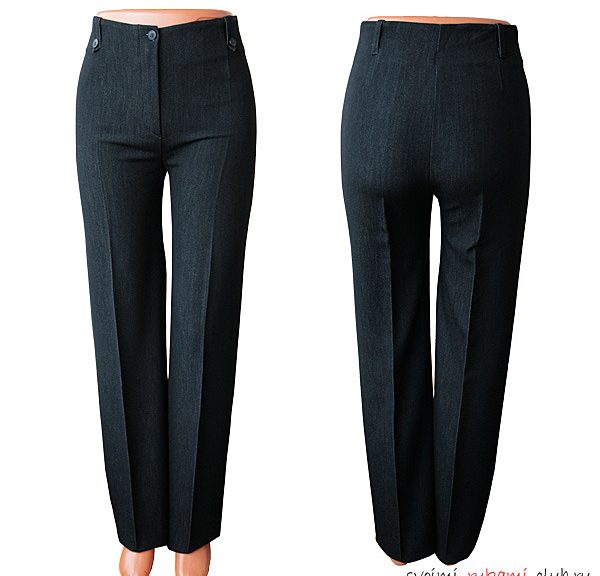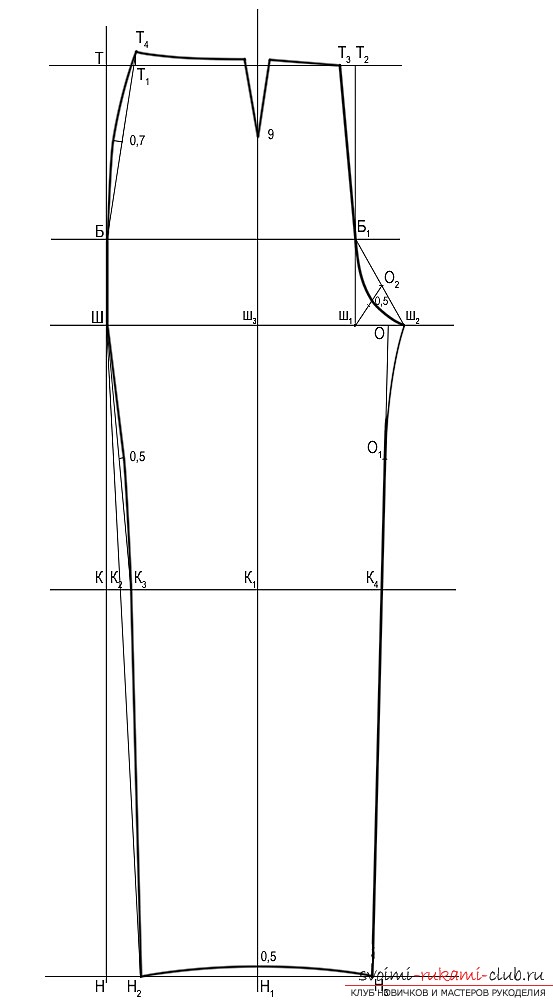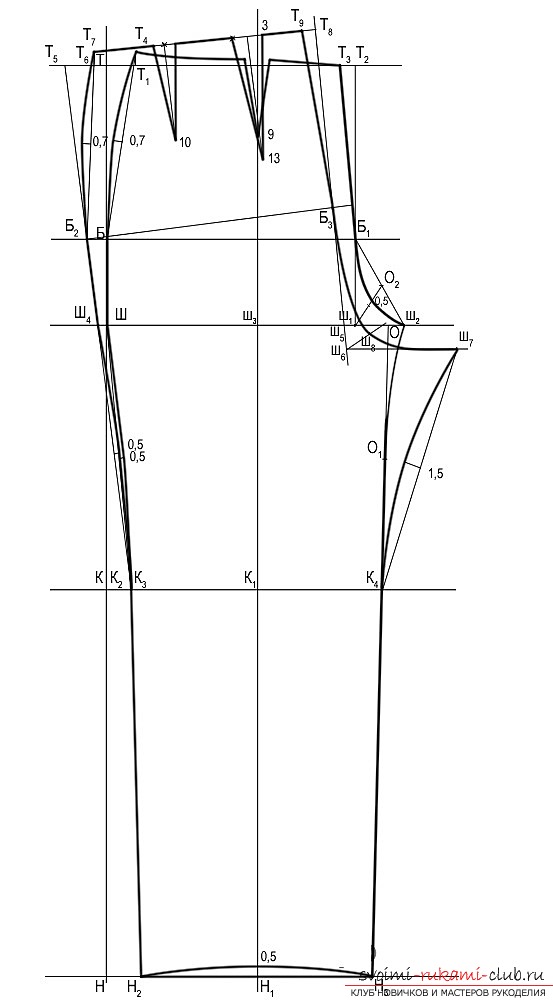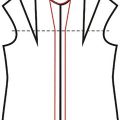
Useful schemes and instructions for the design of classic women's pants. We make an excellent outfit for every occasion of life
The classic model of trousers for women is designed forany shape. They will look elegant, like a young girl, and an elderly woman. With such a dress, any blouse or jacket perfectly matches.  To create a pattern of classic trousers, you will need to first make such measurements:
To create a pattern of classic trousers, you will need to first make such measurements:
- Semicircumference of waist - 38;
- The size of the semicircle of the hips is 52;
- The length on the side is 102;
- The front length is 100.5;
- The length of the first step is 72.5;
- The length of the second step is 70;
- The knee waist is 57;
- Seat height - 28;
- Thigh volume - 59;
- A control measure;
- The width of the bottom of the trousers is 24;
In our example, we will use our ownoptions. We will build the front half of the classic trousers for women. Mark the right angle, its vertex is the point T. From it along the vertical we debug the measurements. To denote the length of the trousers, you need to take two and a half centimeters from our front length measurement. 100.5 - 2.5 = 98 centimeters. We draw a straight line of this length and put the point H. To find out the depth of sitting, it is necessary to take the length of the front from the length of the first step. It turns out: 100.5 - 72.5 = 28 centimeters. We put the point W.  You can choose how your pants arewill fit in the groin area. If desired, add or subtract one centimeter to the difference presented. For more loose trousers the value will be 29 centimeters, and for the tight-fitting - 27 centimeters. For classic trousers, the length to the thigh line is equal to the two third segments of the TS. In our example, this will be 18.7 centimeters. We designate this segment as TB. Up to the line of knees, the length of the trousers will be equal to the measure taken already of the length of the waist of the knee. We put the point K, we have a segment of TC for 57 centimeters. Also, you can simply divide the distance between D and H into two lengths, and get the desired point K. Pass through the new points H, K, B, D flat horizontals. Determine the width of the front half of the trousers along the line of the step. It is necessary to add an indentation of two centimeters to the length of the semicircle of the hips, and then divide it in half. It turns out (52 + 2) / 2 = 27 centimeters. We designate it as a segment of Nil1. To measure the width of the bow, divide the previous amount by ten. (52 + 2) / 10 = 5.4 centimeters. We denote the new segment as W1W2. Now we need to divide the distance between W and W2 by two, obtaining point W3. Through it we draw a vertical line, which will be the line of the jaws of our trousers. Mark two newly formed points K1 and H1. The width of the trousers from below is chosen at will, we have 24 centimeters. Divide this value by two and get 12 centimeters. From the point H1 in both directions, left and right, we debug the resulting value. New segments, 12 centimeters long, are designated as H1H2 and H1H3. We draw a line from W to H2 and obtain the point K2. From it we debug in the right side a notch along the line of the knees. Thus, we make out the side seam of trousers. The segment K2K3 is equal to one centimeter. Now you need to equalize the width of the front half of the female trousers along the line of the knees. We look from the jaw line to the left and to the right. To do this, from point K1 to the right we draw a segment K1K3. Both straight lines K1K3 and K1K4 are equal to each other. We connect by means of a straight line H3 and K4. We extend it a little to put a new point O. We divide the resulting segment K4O into two equal parts, in the middle we put the point O1. Through the points K4, D1 and S2 we draw a smooth concave line. Thus, a line is obtained, which is a stepping cut of the front half of the female trousers. From point W1 we draw upwards a perpendicular line. At points of intersection of this perpendicular with a horizontal line of hips and waist, mark T2 and B1. We connect the new point D1 with W2, divide this segment in half and mark the point O2. The new segment O2Si1 is also divided into two equal parts and from the middle up we rise by half a centimeter. The bevelled line of the bow at the waist is selected from 0, 1 or 1.5 centimeters. In our case, the segment T2T3 is equal to one and a half centimeters. A zero centimeter is selected for the figures with the stomach, as well as for the fabric in the strip and the cage. Draw a smooth concave line through points T3, B1, W2, 0.5. The resulting line is the bow line of the front half of the classic trousers. To calculate the tala and lateral tucks, you need to find the difference between the semicircle of the hips and waist, not forgetting about the indentation. We get: (52 + 2) - (38 + 1) = 15 centimeters. To get the sum of the side darts of the front and back half of the trousers, divide our 15 centimeters into two: 7.5 centimeters. If we again divide 7.5 centimeters in half, we get the value of the side tuck of the front and back half of the classic trousers. We mark this segment as TT1. The remaining 7.5 centimeters should be distributed on such thawed taps: one third, 2.5 centimeters, the front half, and the remainder, 5 centimeters, to the rear. The increase in waist in the area of the side seam is calculated in this way. From the length on the side we take the length from the front: 102 - 100.5 = 1.5 centimeters. If from T1 upwards to spend one and a half centimeter, we will receive T4. Straight line connect B with T4. Then divide it equally and pass to the left a perpendicular for the convexity of the thighs. It is 0.5 or 0.7 or 1 centimeter. Depends on your settings and preferences. We connect K3 to the point W, divide the resulting segment equally and set the perpendicular to the right for the concavity of the thighs to the right. Its value is from 0.3 to 0.5 centimeters. Under the template make the lateral seam of the front half of the trousers through points T4, 0,7, B, Ш, Н2, К3 and 0,5. In the middle of the jaw line, we build the hip-in tuck of the front half of the trousers. To do this, you need to connect T3 and T4 together, debug the depth of the dart, which is equal to 2.5 centimeters. The length of the dart is 9 centimeters. Equate both sides of the tuck to the left. Beautifully decorate the waist line. From point H1 we will rise upwards on half-centimeter, and we will spend a smooth line of a bottom through such points: Н2, 0,5 and Н3. If the fabric is not particularly docile when ironing, climb one centimeter. Now let's build the back half of the classic trousers for women. The expansion of trousers along the stride lines is one centimeter. From point W to the left, draw one centimeter and you will get point W4. Using a straight line, connect the points W4 and K3, and after a while, extend the segment a little to get two points B2 and T5. From point B2 to the inclined line, we draw a perpendicular and from it to the right mark the width of the back half of the trousers on the thigh line. We consider thus: (52 + 2) - 27 = 27 centimeters.
You can choose how your pants arewill fit in the groin area. If desired, add or subtract one centimeter to the difference presented. For more loose trousers the value will be 29 centimeters, and for the tight-fitting - 27 centimeters. For classic trousers, the length to the thigh line is equal to the two third segments of the TS. In our example, this will be 18.7 centimeters. We designate this segment as TB. Up to the line of knees, the length of the trousers will be equal to the measure taken already of the length of the waist of the knee. We put the point K, we have a segment of TC for 57 centimeters. Also, you can simply divide the distance between D and H into two lengths, and get the desired point K. Pass through the new points H, K, B, D flat horizontals. Determine the width of the front half of the trousers along the line of the step. It is necessary to add an indentation of two centimeters to the length of the semicircle of the hips, and then divide it in half. It turns out (52 + 2) / 2 = 27 centimeters. We designate it as a segment of Nil1. To measure the width of the bow, divide the previous amount by ten. (52 + 2) / 10 = 5.4 centimeters. We denote the new segment as W1W2. Now we need to divide the distance between W and W2 by two, obtaining point W3. Through it we draw a vertical line, which will be the line of the jaws of our trousers. Mark two newly formed points K1 and H1. The width of the trousers from below is chosen at will, we have 24 centimeters. Divide this value by two and get 12 centimeters. From the point H1 in both directions, left and right, we debug the resulting value. New segments, 12 centimeters long, are designated as H1H2 and H1H3. We draw a line from W to H2 and obtain the point K2. From it we debug in the right side a notch along the line of the knees. Thus, we make out the side seam of trousers. The segment K2K3 is equal to one centimeter. Now you need to equalize the width of the front half of the female trousers along the line of the knees. We look from the jaw line to the left and to the right. To do this, from point K1 to the right we draw a segment K1K3. Both straight lines K1K3 and K1K4 are equal to each other. We connect by means of a straight line H3 and K4. We extend it a little to put a new point O. We divide the resulting segment K4O into two equal parts, in the middle we put the point O1. Through the points K4, D1 and S2 we draw a smooth concave line. Thus, a line is obtained, which is a stepping cut of the front half of the female trousers. From point W1 we draw upwards a perpendicular line. At points of intersection of this perpendicular with a horizontal line of hips and waist, mark T2 and B1. We connect the new point D1 with W2, divide this segment in half and mark the point O2. The new segment O2Si1 is also divided into two equal parts and from the middle up we rise by half a centimeter. The bevelled line of the bow at the waist is selected from 0, 1 or 1.5 centimeters. In our case, the segment T2T3 is equal to one and a half centimeters. A zero centimeter is selected for the figures with the stomach, as well as for the fabric in the strip and the cage. Draw a smooth concave line through points T3, B1, W2, 0.5. The resulting line is the bow line of the front half of the classic trousers. To calculate the tala and lateral tucks, you need to find the difference between the semicircle of the hips and waist, not forgetting about the indentation. We get: (52 + 2) - (38 + 1) = 15 centimeters. To get the sum of the side darts of the front and back half of the trousers, divide our 15 centimeters into two: 7.5 centimeters. If we again divide 7.5 centimeters in half, we get the value of the side tuck of the front and back half of the classic trousers. We mark this segment as TT1. The remaining 7.5 centimeters should be distributed on such thawed taps: one third, 2.5 centimeters, the front half, and the remainder, 5 centimeters, to the rear. The increase in waist in the area of the side seam is calculated in this way. From the length on the side we take the length from the front: 102 - 100.5 = 1.5 centimeters. If from T1 upwards to spend one and a half centimeter, we will receive T4. Straight line connect B with T4. Then divide it equally and pass to the left a perpendicular for the convexity of the thighs. It is 0.5 or 0.7 or 1 centimeter. Depends on your settings and preferences. We connect K3 to the point W, divide the resulting segment equally and set the perpendicular to the right for the concavity of the thighs to the right. Its value is from 0.3 to 0.5 centimeters. Under the template make the lateral seam of the front half of the trousers through points T4, 0,7, B, Ш, Н2, К3 and 0,5. In the middle of the jaw line, we build the hip-in tuck of the front half of the trousers. To do this, you need to connect T3 and T4 together, debug the depth of the dart, which is equal to 2.5 centimeters. The length of the dart is 9 centimeters. Equate both sides of the tuck to the left. Beautifully decorate the waist line. From point H1 we will rise upwards on half-centimeter, and we will spend a smooth line of a bottom through such points: Н2, 0,5 and Н3. If the fabric is not particularly docile when ironing, climb one centimeter. Now let's build the back half of the classic trousers for women. The expansion of trousers along the stride lines is one centimeter. From point W to the left, draw one centimeter and you will get point W4. Using a straight line, connect the points W4 and K3, and after a while, extend the segment a little to get two points B2 and T5. From point B2 to the inclined line, we draw a perpendicular and from it to the right mark the width of the back half of the trousers on the thigh line. We consider thus: (52 + 2) - 27 = 27 centimeters.  To arrange the seating line, from point W1 to the leftspend one centimeter. We denote the point Ws. We connect it with B3, extending the straight line up and down. To calculate the reduction of the step line, it is necessary to take the second step from the first step length: 72.5 - 70 = 2.5 centimeters. We have obtained a segment W5Si2. Find the width of the seat line. We divide the semicircle of the hips by four. 52/4 = 12 centimeters - the straight line W6SH7. We draw the bisector from the point W6 by 1.5, 2.5 or 3 centimeters. Our segment W6SH8 is 2.5 centimeters. We connect straight line Ш7 to К4, then divide it in half and go to the left perpendicular to 0,7 - 1,5 centimeters. We make a step cut of trousers through the points W7, 1.5, K4 and H3. We will tackle the side seam of trousers. The lateral recess at the waist is 3.75 centimeters. We draw this length from T5, and put T6. Up we debug the difference between the length on the side and the front: 102 - 100.5 = 1.5 centimeters, point T7. In the middle between it and B2 to the left we draw a perpendicular to 0.5 or 0.7 or 1 centimeter to denote the convexity of the hips. Line N4K3 divide in half and to the right we spend perpendicular to 0.3 or 0.5 centimeters. The lateral suture is carried through 0.7, 0.5, T7, B2, W4, K3, H2. From T7 we draw a perpendicular to the inclined line, we denote the point T8. From it to the left we spend the bevel from 1 to 1.5 centimeters. A segment of T8T9 measuring 1.5 centimeters. The seat line passes through T9, B3 and the bisector to the points W8 and W7. On the waist line we build darts. First, divide the waist into three parts. The first dart at 3 centimeters, is located to the right of the division point. The size of the dart is from 11 to 13 centimeters. From the point of division we recede 3 centimeters, divide the resulting segment equally and conduct a perpendicular to 13 centimeters. We build a dart by calling the sides. The second dike is two centimeters deep. It is at the second point of division, its size is 10 centimeters. At the point of division, we draw a perpendicular to 10 centimeters, build a dart and equalize the sides. We form the horizontal line of the bottom through the points H2, H1 and H3.
To arrange the seating line, from point W1 to the leftspend one centimeter. We denote the point Ws. We connect it with B3, extending the straight line up and down. To calculate the reduction of the step line, it is necessary to take the second step from the first step length: 72.5 - 70 = 2.5 centimeters. We have obtained a segment W5Si2. Find the width of the seat line. We divide the semicircle of the hips by four. 52/4 = 12 centimeters - the straight line W6SH7. We draw the bisector from the point W6 by 1.5, 2.5 or 3 centimeters. Our segment W6SH8 is 2.5 centimeters. We connect straight line Ш7 to К4, then divide it in half and go to the left perpendicular to 0,7 - 1,5 centimeters. We make a step cut of trousers through the points W7, 1.5, K4 and H3. We will tackle the side seam of trousers. The lateral recess at the waist is 3.75 centimeters. We draw this length from T5, and put T6. Up we debug the difference between the length on the side and the front: 102 - 100.5 = 1.5 centimeters, point T7. In the middle between it and B2 to the left we draw a perpendicular to 0.5 or 0.7 or 1 centimeter to denote the convexity of the hips. Line N4K3 divide in half and to the right we spend perpendicular to 0.3 or 0.5 centimeters. The lateral suture is carried through 0.7, 0.5, T7, B2, W4, K3, H2. From T7 we draw a perpendicular to the inclined line, we denote the point T8. From it to the left we spend the bevel from 1 to 1.5 centimeters. A segment of T8T9 measuring 1.5 centimeters. The seat line passes through T9, B3 and the bisector to the points W8 and W7. On the waist line we build darts. First, divide the waist into three parts. The first dart at 3 centimeters, is located to the right of the division point. The size of the dart is from 11 to 13 centimeters. From the point of division we recede 3 centimeters, divide the resulting segment equally and conduct a perpendicular to 13 centimeters. We build a dart by calling the sides. The second dike is two centimeters deep. It is at the second point of division, its size is 10 centimeters. At the point of division, we draw a perpendicular to 10 centimeters, build a dart and equalize the sides. We form the horizontal line of the bottom through the points H2, H1 and H3.  That's all. Our trousers are completely ready for tailoring.
That's all. Our trousers are completely ready for tailoring.




